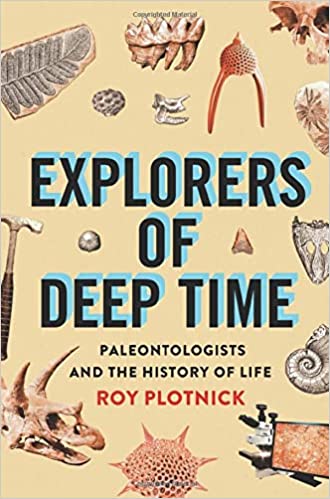Explorers of Deep Time, by Roy Plotnick
Duncan White (UK)

There is much to be enjoyed in this engaging book by Roy Plotnick, in which he brings the modern practice of palaeontology – and palaeontologists themselves – vividly to life.
One excellent device that he makes use of repeatedly is that of ‘boxes’ – inserts of text scattered throughout the book – in which he allows named palaeontologists to describe in their own words how they came into palaeontology, what they’ve done, and what aspects of palaeontology they love – and which they hate. This shows clearly the sheer variety of routes that different people have taken to get into the science. This reader came away with the feeling that there is no single, standard, route into palaeontology. That is, everyone finds their own route.
Plotnick also describes the wide variety of cool pieces of technological kit that modern palaeontologists use these days, ranging from Scanning Electron Microscopes, via 3-D scanners and printers, to Geographic Information Systems and open-source fossil databases. But don’t worry, he doesn’t overlook the basic tools of paleontological fieldwork – the trusty geological hammer and chisel, hand lens, safety glasses and a notebook. He also describes some of the challenges of fieldwork trips to remote places, such as a 2012 trip to Mongolia involving living in tents, with a cold stream for bathing, and no toilet facilities for weeks.
He does not skip the less pleasant side of the professional life of a palaeontologists: sexual harassment, bad behaviour at conferences, bandits in remote areas (really) and the historic drinking culture.
He also covers many other topics, in some depth, but always entertainingly. Some of them are:
- museums and working in them
- academic careers in palaeontology (writing research papers, teaching, funding and getting tenure)
- threats to palaeontology (especially museum and geology department closures)
- what palaeontology can tell us about climate change and evolution
- the paleontological community and their conferences
- the challenges of commercial fossil collecting
- working with amateur fossil collectors
- the challenges of land rights (in an American context), and
- public understanding of palaeontology.
There is, however, one drawback about this book from a British/Europeanperspective. Plotnick is an American palaeontologist who’s spent his whole career in the American paleontological context. That’s fair enough, of course, but this book would, in this reader’s opinion, be much improved if it paid more attention to palaeontology around the world.
As one tiny example, when he lists examples of great natural history museums early in the book, every single one is American. Are there no other great natural history museums anywhere else? London, Paris and Berlin, for example?
This US-bias also affects some of the topics: research funding, the quest fortenure, land rights, commercial collecting, and the interactions between amateur and professional fossil collectors. These were are all described from an exclusively US perspective, and would have been immeasurably improved withan international dimension. As an amateur fossil hunter, I rather strongly disagreed with some of the negative views of amateurs that he reports fromsome of his colleagues.
In the final chapter (the ‘World of Paleontology’) Plotnick admits his US bias and tries to briefly describe palaeontology in other countries. This material is very interesting, but is a whistle stop tour, lacking in depth. (I wondered whether this final chapter was added because an earlier reviewer identified US bias as a problem.)
However, despite its US bias, this is a fascinating and well-written discussion of Plotnick’s life in palaeontology. It shows particularly clearly how – in the US at least – palaeontology has transformed over Plotnick’s lifetime from the hands-on ‘dig up fossils in the wild’ to the more theoretical, statistical, big data driven, high technology field hedescribes. I very much wanted to know whether this transformation is largely US-specific, or is happening worldwide.
One way the book opened my eyes was in the sheer number of different ways that one may become a professional palaeontologist, and the sheer diversity of the different roles that palaeontologists occupy today.
Overall, I would definitely recommend this book. It’s engaging, enthusiastic, and packed with interesting recollections of Plotnick’s life and career inpalaeontology.
Explorers of Deep Time Publisher, by Roy Plotnick, Columbia University Press (2022), 344 pages (hardback), ISBN-13: 978-0231195348.